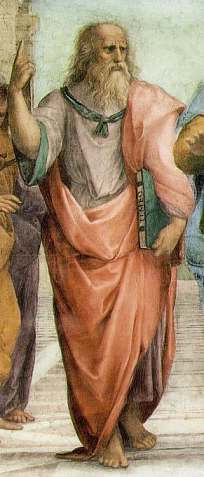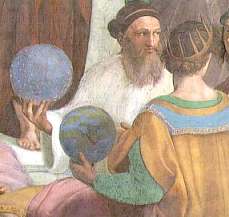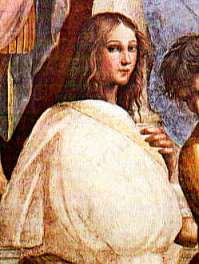.
Part 1
Raffaels Schule von Athen. Wer ist wer?
After he had been welcomed very affectionately by Pope Julius, Raphael started to paint in the Stanza della Segnatura a fresco showing the theologians reconciling Philosophy and Astrology with Theology, in which are portraits of all the sages of the world shown disputing among themselves in various ways. The original name of the fresco actually is Causarum Cognitio (Knowledge of Causes) but it is called School of Athens from a 17th century guidebook.
The School of Athens ( 5.77 m * 8.14 m ) was painted by the 27 year old Raphael (Raffaelo) Sanzio (or Santi) for Pope Julius II (1503-1513). In 1508 the young native of Urbino had been recommended to Julius II by Donato Bramante, the pope's architect, and also a native of Urbino. So enthusiastic was the pope when he saw the fresco that Raphael received the commission to paint the entire papal suite. The Stanza della Segnatura was to be Julius' library, Bibiotheca Iulia, which would house a small collection of books intended for his personal use. The Fresco of Raphael's School of Athens is a masterpiece of Art. However we do not know all details of the persons who are depicted. Giorgio Vasari and others have suggested nearly all Greek philosophers and ancient scientists can be found here. Unfortunately Raphael did not leave any personal notes on this work but some of the persons can be identified. The work shows that Raphael was an educated person, had some knowledge of Greek philosophy and science. We can consider “The School of Athens” as a “ visualization of knowledge”.

The School of Athens (1510-1511), Raphael (6.4.1483 – 6.4.1520). The building is a modification of Bramante's first design for St Peter's.
Virtual Reality Tour (Stanza della Segnatura), Musei Vaticani (with other works of Raphael also completed in the period 1508-1511)
Plato and Aristotle as Central Figures walking in a peripatetic manner through the Lyceum. A one-point (linear) perspective is used , one method to show 3-D objects on a 2-D surface. Lines which appear to go away from the viewer meet at a single point on the horizon, the so called vanishing point. The perspective is such that this point is between Plato and Aristotle stressing the importance of these two persons. To an almost equal distance between Plato and Aristotle we have Euclid (23) and Pythagoras (30). I see a transition from Philosophy to pure Science from left to right that also is represented by Apollo and Athena sculptures on the left and right side. Many figures (all except Socrates?) were drawn according to persons of Raphael's epoch such as Plato whose face is that of Leonardo. There is also, although not perfect or proportional, some temporal ordering of the persons from the center.
Studies

Study on the " School of Athens "
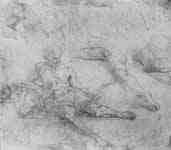
Study on the " School of Athens "
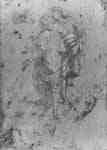
Study on the " School of Athens "
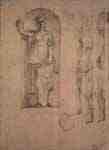
Study on the " School of Athens "
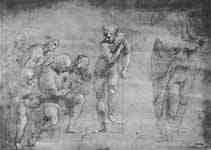
Study on the " School of Athens "
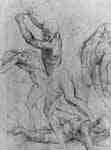
Study on the " School of Athens "
Plato's Academy (or should it be better called Plato's park of olive trees?) as "The School of Athens". Was Plato's Academy founded earlier by Democritus? Cicero gives a part of the following list as heads of "Plato's Academy":
Democritus
Anaxagoras
Empedocles
Parmenides
Xenophanes
Socrates
Plato 387 BC (usually considered as the foundation year of the academy... )
Speusippus (Aristotle dissapointed that he did not follow Plato, later opens the Lyceum school, named so because it was dedicated to Apollo Lykeios )
Xenocrates of Chalcedon
Polemno
Crates
Crantor
Arcesilaus 265 BC (considered a reformer of the Academy)
Lacydes of Cyrene
Evander
Hegesinus
Carneades
Clitomachus
----- The Romans with Lucius Sulla in Athens
Philo 85 BC (one year after Sulla) goes to Rome, Academy probably closed
....
In 2nd century AD continuation
Damascius 529 AD last head after the Byzantine Emperor orders the closing of the "pagan" Academy (Christian religion is the only religion allowed)
1 Plato (Πλάτων ο Αθηναίος) (427-347 BC)
Plato (427 - 347 BC) holds a copy of his Timaeus, and gestures upward to the aetherial realm of his eternal forms. This Plato is probably a portrait of Leonardo da Vinci.
2 Aristotle (Αριστοτέλης ο Σταγειρίτης) (384 - 322 BC)
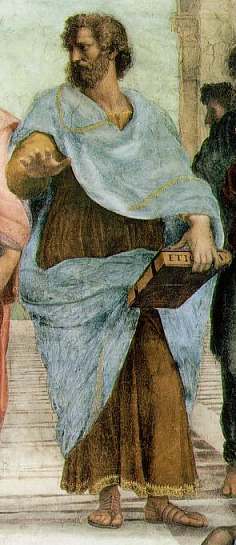
Aristotle of Stagira (384 - 322 BC) (according to Dante Alighieri "The Master of those who know") stretches his hand. He holds a copy of his Nichomachean Ethics -- and he indicates with his gesture the worldliness, the concreteness, of his contributions to philosophy. Nicomachus was the father of Aristotle but also his son was called Nicomachus (the mother some say was Herpyllis a concubine of Aristotle which he married after the death of his wife Pythias).
Does his brown and blue colored clothes represent the two elements water and earth (probably to show that his philosophy is grounded, material), whereas Plato's two colors represent fire and air?
3-6 ?
7 Diogenes of Sinope “The dog” (Διογένης ) (412 – 323 BC)
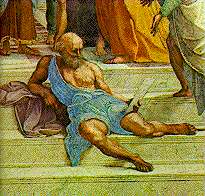
And I," said he, "am Diogenes the dog." And when he was asked to what actions of his it was owing that he was called a dog, he said, "Because I fawn upon those who give me anything, and bark at those who give me nothing, and bite the rogues." Diogenes Laertios, Life of Diogenes
Diogenes of Sinope (412-323 BC), a cynic philosopher, a student of Antisthenes, who lived in Corinth. His father Icesias was a banker. With his “beggar” cup, lying deep in thought on the steps; this is a finely conceived figure which deserves high praise for its beauty and the appropriate negligence of its clothing. Diogenes is seen alone, set apart: [...] a cynic in his expression, in his bearing, in his attitude. What is he reading? Diogenes, a philosopher, lived in a big barrel, instead of the traditional house. He spent his nights wandering from house to house with a lantern, knocking on peoples' doors to find out if there was "an honest human inside." With his audacious intrusion in peoples' private affairs, he meant to show them that no honest person could be found anywhere in his city. When Alexander the Great went to meet him, he found him sitting in front of his barrel, facing the sun. As a great admirer of Diogenes, Alexander then asked him if there is anything he could give him, which today might be equivalent to being asked whether you would like to win the lottery. Diogenes thought for a while, and then asked politely if the Great King could simply... step aside, because by standing over him with his horse, he was hiding the sun from his face! This answer so impressed Alexander, that he exclaimed that if he were not Alexander, he would have liked to be Diogenes!
Some have consider this figure to represent Socrates and his cup the hemlock cup, but Socrates prefered not to be isolated and was involved in discussions. A recent study has shown that among various Greeks the Cretans spent most of their time talking, although the number given of 8 hours per day is maybe not realistic, the Peloponnesians are less interested, keeping their Spartan Laconic tradition
8-10 ?
11 Young Student
12?
13? Plotinus (204/5 - 270) AD ?
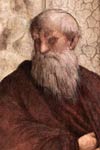
Plotinus, the founder of Neo-Platonism. Was he and his work known around 1510 in Italy? Probably yes from a Latin translation of his work by Marsilio Ficino published in 1492. He influenced many modern Philosopher's even sometimes unacknowledged. He is described by Porphyry as otherworldly which maybe is the reason that he is shown isolated (although some of the person's he knew appointed him as the guardian to their children).
14-18 ?
19 Strabo (Στράβων ο Αμάσειος) or Zoroaster
Zoroaster (c.628 - c.551 BC) but more probably Strabo, a Greek geographer, probably the portrait of Castiglione. Strabo is holding a celestial globe, almost spinning at the tip of his right hand's fingers. To Renaissance humanists, Strabo was considered as a philosopher who insisted to consider the Earth linked with the celestial universe. Translation of his Geography in Latin was commissioned by Pope Nicholas V in the 1450s. A manuscript edition was owned by Julius II. Strabo was often linked with Ptolemy, as a pair, by Renaissance humanists. Some guess that it is the portrait of Pietro Bembo (1470–1547), an Italian humanist and a cardinal.
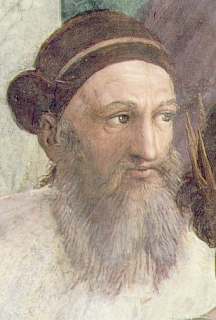
R Raphael as Apelles (Απελλής) (c. 370 – c. 310 BC)
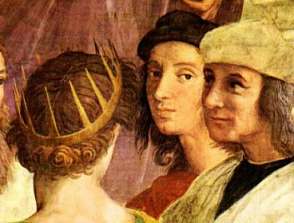
Probably the most provocative part of the School of Athens, Raphael in the center (on the right side Sodoma) is seen among the greatest minds, like Alfred Hitchcock in his films. Why did the Pope accept this?
The Greek painter Apelles (Απελλής), shown as a self-portrait by Raphael who had been nicknamed by Vasari the "new Apelles. Raphael is directly gazing at us, as if he was questioning what we thought about his painting. Apelles was probably the most important Greek painter born about 370 BC in Colophon. He studied at Ephesus and spent 12 years at Sikyon. He worked for Alexander the Great and his father Philip. None of his works survived! Apelles used to show his pictures to the public listening to comments. A shoemaker once faulted the painter for a sandal with one loop too few, which Apelles corrected. The shoemaker, emboldened by this acceptance of his views, then criticized the subject's leg. According to Pliny Apelles replied to this that the shoemaker should not judge beyond his sandals. He is also famous for saying: “Not a day without a line”, i.e. do something every day!
Christianity defeated and wiped out the old faith of the pagans. Then with great fervour and diligence it strove to cast out and utterly destroy every last possible occasion of sin; and in doing so it ruined or demolished all the marvelous statues, besides the other sculptures, the pictures, mosaics and ornaments representing the false pagan gods; and as well as this it destroyed countless memorials and inscriptions left in honor of illustrious persons who had been commemorated by the genius of the ancient world in statues and other public monuments….their tremendous zeal was responsible for inflicting severe damage on the practice of the arts, which then fell into total confusion. Giorgio Vasari (1511-1574), Lives of the Artists.
The School of Athens represents the great personalities in The Seven Liberal Arts which is divided in the Quadrivium (“The four roads”, Arithmetic, Geometry, Music, and Astronomy) and the Trivium (“The three roads”, Grammar, Logic, and Rhetoric) of Sciences. Persons representing these Arts are shown in Groups in Raphael's work. Philosophy considered as something that was important for all arts is shown sometimes in images in form of a central figure, a woman “Philosophia”, nourishing the surrounding personified Seven Liberal Arts. Plato and Aristotle are symbolically used for the Philosophy as central figures.
But where are the painters? Maybe Raphael as an artist represented by Apelles wanted to include also the painters as creative persons in the list of Liberal Artists. Painters were considered more as technicians (as representatives of the Artes Illiberales, those arts which are required for gaining a livelihood) and Raphael has choosen to be shown isolated in the right edge (together with another painter, Sodoma).
Arts experts say that “Art” as we understand it today is something developed only in the 18th century, and the “artists” before were actually only artisans. Is Raphael an artisan and his work just “decoration” or is Raphael an artist? Raphael died young on his 37th birthday but as Vasari writes he succeded in promoting the Arts of painting: “In short, he did not live like a painter, but as a prince. For this cause, O Art of Painting, you may consider yourself fortunate in having possessed an artist who, by his genius and character, has raised you above the heavens”
20 Claudius Ptolemy (Πτολεμαίος Κλαύδιος) (c. 87 – c. 170 AD)
Back view of Ptolemy holding earth sphere, facing Strabo (or Zoroaster, represented as an astrologer), holding a celestial sphere. An explanation is that Raphael used the motif of the crown found on coins from the "dynasty of Macedonian kings of the same name who ruled Egypt from 323 to 30 BC
21 Sodoma (1477 Vercelli in Piedmont – 1549 Siena)
Greek painter Protogenes shown as Raphael's good friend, the painter Timoteo da Urbino (Timoteo Viti) with whom he had professional and personal contacts when he painted this fresco (Joost-Gaugier 1998). Maybe a reference to homosexuality linked with these men professional activity as painters? Some say it is GIOVANNI ANTONIO BAZZI, or DE'BAZZI, often miscalled RAZZI, more usually known by his nickname, SODOMA, a Piedmontese and Florentine painter. He must be regarded as an extraordinary genius, because at times he reached the very highest of his ideals, and then at times completely failed. He must also be regarded as a man against whom many writers have thrown mud, and who now can be safely considered as a far greater man than his contemporaries regarded him, and not so evil in disposition as many were prepared to believe him to be. (Catholic Encyclopedia 1912)
Protogenes was Greek painter and a rival of Apelles.
22 ?
Excitement of dawning comprehension
23 Euclid (Ευκλείδης ο Αλεξανδρεύς)(c. 325 - c. 265 BC) or Archimedes(Αρχιμήδης ο Συρακούσιος) (287 – 212 BC) ?
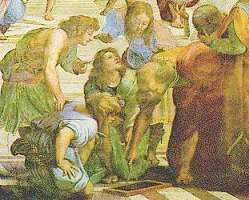

Geometry is represented by Euclid bending down to draw on a slate tablet with a pair of dividers(looking like the architect Bramante of Urbino (the architect of St. Peter's) according to some experts), who is explaining to his pupils a geometric diagram he has drawn on a slate. Other say that Archimedes is shown in a pose like when he was killed by a Roman soldier. The figure immediately behind and slightly above is some say that of Federico Gonzaga. Bramante used geometry for the design of buildings and was selected to represent one of the two geometers. From the surrounding persons that look like students it is more likely that Euclid is shown as I do not know that Archimedes was also a teacher like Euclid. 17, 24, 22, 18 some say represent the four stages of learning: 17 is intent but at the level of literal learning, and 24, with his pointing finger and encouraging pat seems to be an apprentice teacher; 22 is turning to his companion with the excitement of dawning comprehension, but 18 is already anticipating the outcome.
24-25 ?
26 Heraclitus (Ηράκλειτος) (c. 544 - 483 BC)
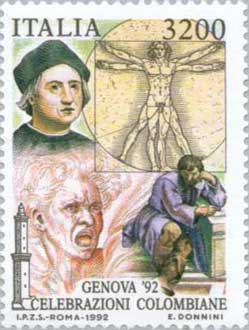
Heraclitus in front of the Vitruvius Man, 500 years anniversary of the Columbus Voyage
The whole design has but one fault, ... Heraclitus, in the foreground writing in an impossible attitude on a desk ....It is such a blot upon the picture that one cannot believe that Raphael added it of his own motion; rather it must have been placed there at the dictation of some meddling cardinal or learned humanist who, knowing nothing of art, could not see why any vacant space should not be filled with any figure whose presence seemed to him historically desirable. One is tempted to suspect even, so clumsy is the figure and so out of scale with its neighbors, that the master refused to disfigure his work himself and left the task to one of his apprentices. If it had been done by one of them, say Giulio Romano, after the picture was entirely completed and at the time of the "Incendio del' Borgo," it could not be more out of keeping. Kenyon Kox
Heraclitus, looking like Michelangelo (his true name was Michelagniolo di Ludovico di Buonarroto Simon (6.3.1475 – 18.2.1564) Sculptor, Painter, Architect, Vatican). Heraclitus is also called the dark melancholic philosopher, maybe this is the reason why he is shown thinking and serious. He is alone because he usually did not like others and in the “School of Athens” he and Diogenes are clear isolated figures.
Assumed to be inspired by Michelangelo's work of Jeremiah (Chapelle Sixtine, finished 1511?) (Like the melancholic Heraclitus Jeremiah is known from his Lamentations: “He hath led me, and brought me into darkness, and not into light”). But also Michelangelo liked to be alone and although he obtained from the Pope much more money for his work than any other artist he was a scrooge.

Jeremiah, Michelangelo
27 Parmenides (Παρμενίδης ο Ελεάτης) (c. 510 – after 450 BC ?) ?
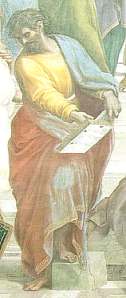
Probably Parmenides (c. 510-after 450 as late as 415 BC) or the mathematician and musician Nicomachus of Gerasa (Νικόμαχος ο Γερασηνός) (c. 60- c. 120 AD). Nicomachus was the author of Arithmetic Introduction.
28 Hypatia (Υπατία) (or Francesco Maria della Rovere I )
Some consider it as Hypatia saying that:
Upon Raphael's submission of a draft of the fresco to the church fathers, the Bishop is alleged to have inquired as to the identity of a woman depicted at the bottom (front) and center of the sketch, between the figures of Heraclitus and Diogenes, “Who is this woman in the middle?” “Hypatia, the most famous student of the School of Athens,” replied the artist. “Remove her. Knowledge of her runs counter to the belief of the faithful! Otherwise, the work is acceptable,” cautioned the Vatican's high priest. Yielding to the power of the purse strings, Raphael's only option was to remove the figure, but he then could proceed instead to disguise his original intention as an intimate gesture to his holy patron.
Other say that the person is Francesco Maria della Rovere I, the duke of Urbino, the pope's nephew, around thirty at that time. Raphael produced also another portrait that is assumed to represent Rovere which has some similarities as the figure in the “School of Athens” and a female look. Why did he include this person in the School of Athens, because he was a relative of the Pope only or did he use his appearance to represent Hypatia of Alexandria?
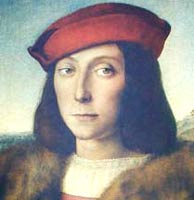
Part of a portait by Raphael assumed to represent Francesco Maria della Rovere (1490-1538)
29 Pythagoras disciple holding an abacus "on which the numbers are depicted and the consonances of song
Some say that this young is actually Anaxagoras of Clazomenae (499-428)BC other say it is Archytas
Part 2 includes the other persons and variations such as the “School of Hollywood”
The Apotheosis of Homer, Who is Who?
Poem: The School of Athens
The Academy of Plato
Perspective as a Symmetry Transformation
Red Greek Stereo Image of the School of Athens
The Damned in Michelangelo's Last Judgment (The Hell, Hades and Charon)
Books
- Stelios Lydakis, Ancient Greek Painting and Its Echoes in Later Art
Publisher: Getty Publishing ISBN: 0892366834
- E.H. Gombrich , The Heritage of Apelles: Studies in the Art of the Renaissance
Phaidon Press (January 1, 1994) ISBN: 0714820113
| Ancient Greece
Science, Technology , Medicine , Warfare, , Biographies , Life , Cities/Places/Maps , Arts , Literature , Philosophy ,Olympics, Mythology , History , Images Medieval Greece / Byzantine Empire Science, Technology, Arts, , Warfare , Literature, Biographies, Icons, History Modern Greece Cities, Islands, Regions, Fauna/Flora ,Biographies , History , Warfare, Science/Technology, Literature, Music , Arts , Film/Actors , Sport , Fashion --- |

